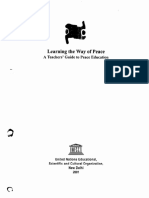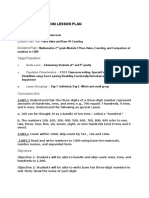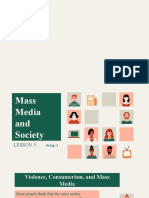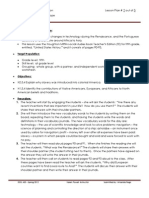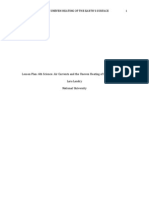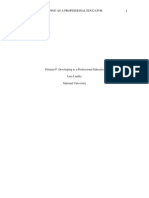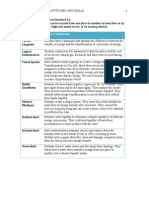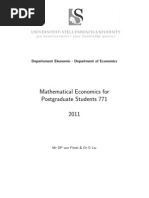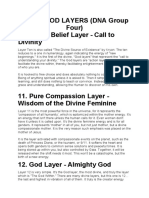Annotated Lesson Plan: The Age of Explorers
Annotated Lesson Plan: The Age of Explorers
Uploaded by
Lara LandryCopyright:
Available Formats
Annotated Lesson Plan: The Age of Explorers
Annotated Lesson Plan: The Age of Explorers
Uploaded by
Lara LandryCopyright
Available Formats
Share this document
Did you find this document useful?
Is this content inappropriate?
Copyright:
Available Formats
Annotated Lesson Plan: The Age of Explorers
Annotated Lesson Plan: The Age of Explorers
Uploaded by
Lara LandryCopyright:
Available Formats
ANNOTATED LESSON PLAN: THE AGE OF EXPLORERS
Annotated Lesson Plan: The Age of Explorers Lara Landry National University
ANNOTATED LESSON PLAN: THE AGE OF EXPLORERS Lesson Description: Content Area: Social Studies Title: The Age of Exploration
Grade Level: 4 (14 students, 2 ADHD, 1 ELL) Rationale: Humans have not always known our Earth to be round, or how great in size it really is. There was much that was unknown to man before the growth of modern technology. Before the Age of Discovery, European's didn't know of the western hemisphere or of the Americas. It wasn't until only 300-500 years ago that the lands were discovered. In purpose of finding new trade routes, new goods and new trading partners, European began exploring the world by sea. Some too set sail to simply learn more about the world. Whatever the reasons, the information gained during the Age of Exploration significantly helped in the advancement of geographic knowledge. This lesson teaches students about our changing world; when, where, how and why the continents of both North and South America came to be known and developed. Goal: Students will learn about the exploration era and the explorers who first came to America. Objectives: Students will be able to 1. Identify the time period of the early explorers 2. Identify the reasons for exploration 3. Identify two prominent religions; Christianity and Islam 4. Identify the goals of the early explorers
ANNOTATED LESSON PLAN: THE AGE OF EXPLORERS 5. Analyze the role of six prominent explorers and evaluate their importance 6. Identify the routes of the explorers of the Americas on a map 7. Access websites to conduct research 8. Cooperate and collaborate with a partner 9. Keep papers and materials organized Standards: CA standard 5.2: Students trace the routes of early explorers and describe the early explorations of the Americas. 1. Describe the entrepreneurial characteristics of early explorers and the technological developments that made sea exploration by latitude and longitude possible.
2. Explain the aims, obstacles, and accomplishments of the explorers, sponsors, and leaders of key European expeditions and the reasons Europeans chose to explore and colonize the world. 3. Trace the routes of the major land explorers of the United States, the distances traveled by explorers, and the Atlantic trade routes that linked Africa, the West Indies, the British colonies, and Europe. 4. Locate on maps of North and South America land claimed by European powers. ELL Accommodations: The teacher introduces new words the students will be exposed to in this lesson; i.e. Renaissance, Vasco de Gama, Portugal, Christianity. The spelling of each new word and the names of the explorers and countries mentioned are written on the board for the class to reference. The teacher reads each new word aloud and the students
ANNOTATED LESSON PLAN: THE AGE OF EXPLORERS repeat them in chorus. When a word is mentioned in the video the teacher thinks may be challenging, the teacher pauses the video to explain. The ELL student is partnered with a student who is willing to be patient in helping him understand the material; one with patience who enjoys helping others. Vocabulary: 1. Exploration: noun for of explore, to make a careful search for something by traveling to different places 2. expedition: a journey especially by a group of people for a specific purpose (such as to explore a distant place or to do research) 3. the Renaissance: the period of European history between the 14th and 17th centuries when there was a new interest in science and in ancient art and literature especially in Italy 4. 5. 6. 7. 8. Amerigo Vespucci: an Italian explorer Vasco de Gama: an Explorer from Portugal Portugal: a powerful country during the Exploration Era, neighbor to Spain Portuguese: someone from Portugal religion: an organized system of beliefs, ceremonies, and rules used to worship a god or a group of gods Christianity: the religion that is based on the teachings of Jesus Christ 9. 10. Muslim: a person whose religion is Islam: a follower of Islam Islam: the religion which teaches that there is only one God and that Muhammad is God's prophet: the religion of Muslims 11. caravels: the ships used by Portugal and other nations to explore
ANNOTATED LESSON PLAN: THE AGE OF EXPLORERS 12. conquer: to take control of (a country, city, etc.) through the use of force
Materials and tools: True/False Pre-quiz Multimedia projector Great Age of Exploration video Video questions handout Explorer Website list handout Computers Internet project fill in the blanks assignment sheet List of Explorers and Accomplishments with dates Blank timeline to fill in Student Post Evaluation Paper Student self-Reflection paper Pencil Colored correcting pen
Procedures: Introduction (5 minutes): Teacher will briefly discuss the Age of Exploration; giving the time period, the objectives, and the outcomes of the European exploration period. Presentation: Day One: Pre-Quiz (5 minutes): The teacher will distribute and ask the students to complete the pre-quiz on the Age of Exploration to see what the students know prior to the lesson.
ANNOTATED LESSON PLAN: THE AGE OF EXPLORERS Video (45 minutes- 1 hour): When the pre-tests are complete the each student is given a
handout with questions to answer on the 30-minute video they will watch, The Great Age of Exploration. The teacher reviews the questions with the class prior to the video presentation. After the video, the students are assigned to heterogeneous groups of 2 students of different skill levels to complete the video questions. Each student will complete their own paper, but they will collaborate with their group members to come up with the correct answers. After the video questions are complete, the teacher leads the students in a discussion on the video and the questions. The answers are shared by the groups with the class and the teacher provides correction where or if needed. The students correct their own papers with a correcting pen. Day Two: Internet Project (45 minutes): In their assigned groups, the students complete a fill in the blank assessment on the early explorers by referencing specific Internet sites in the computer lab. The list of Internet sites they are to access for the information as well as the fill in the blank assessment of their knowledge of the early explorers is given to the students prior to going to the computer lab. The teacher reviews the assignment with the students and answers any questions. Each student has their own paper, but they work together to find the correct answers to fill in. The students will complete this in their groups of 2-3 students. The teacher walks the computer lab while the students complete the assignment and is readily available to assist in locating information on the websites or for any questions the students might have while completing the assignment. The teacher gives praise when the students locate a correct answer. After the students finish filling in the handout, they come back to the classroom and discuss their finding as a group. Each
ANNOTATED LESSON PLAN: THE AGE OF EXPLORERS
group shares the answers to 1-2 of the questions. Any correction that the students make is done in a colored correcting pen. Day Three: Timeline: Students complete a timeline in their groups of the early explorers from a list of explorers given to them. Again, each student has their own paper, but they work together to put the dates and nations in the correct places on the timeline. Day Four: Students complete an open book/note evaluation/test, and closed book True/False posttest. Assessment and Evaluation: The teacher constantly assesses the group work by canvasing the classroom while the students are working. After the video questions are answered, the teacher goes over the worksheet with the class. Each group takes turns giving the answers to the video questions, 2-3 questions per group are shared with the class. If a group got a particular question wrong, they are asked to correct the answer with a colored correcting pen. After the Internet project, the teacher engages the students in discussion about their findings. The answers to each of the questions are reviewed and corrected. After the final assignment where the students complete a timeline of the early explorers, the teacher reviews the handouts for accuracy with the class. The three final papers are submitted and graded. Homework (15 minutes): Given on the third day, the students complete a crossword puzzle on the early explorers. This crossword puzzle has a word bank to help students with their spelling. This is done independently and the assignment is submitted for
ANNOTATED LESSON PLAN: THE AGE OF EXPLORERS grading. The crossword is corrected in class and students make any correction to their paper with a colored correcting pen. Evaluation (20 minutes): The student is given a final "open note" evaluation of their knowledge of early explorers and the Age of Exploration. After, the students re-take the pre-test without notes to see how their knowledge of this era has improved. The final paper to be completed by the students is a self-reflection where the students are asked
four questions about their opinion of the lesson; what they liked the most, the least, what was the most challenging and what was the least challenging. The self-reflection and all other assignments are treated as classwork assignments and are only graded for completion. The test is the summative assessment. All documents needed follow the lesson plan.
ANNOTATED LESSON PLAN: THE AGE OF EXPLORERS Age of Exploration and Early Explorers Pre-Test Directions: Answer the following True/False questions by writing a T for true or F for false to the left of each number. 1. America was called the New World. 2. Christopher Columbus was the first explorer to find the New World. 3. Columbus started the first Spanish colony in the New World. 4. In the 1400s, Spain and Portugal were leaders in world exploration. 5. Vasco Da Gama was a Spanish explorer. 6. In 1400, no Native American had ever seen a horse. 7. The development of gunpowder by the Aztec Indians in Mexico allowed them to win most of their battles against the Spanish. 8. North and South America were named after the Americo plant found only in the New World. 9. Amerigo Vespucci is an explorer for which America was named. 10. Ferdinand Magellan was an explorer who sailed all the way around the world.
ANNOTATED LESSON PLAN: THE AGE OF EXPLORERS
10
"The Great Age Of Exploration" Video Questions
1. What was the time period after the Medieval Era called (it was a historical period of cultural rebirth)?
2. What country developed the important school of navigation in the 1400s?
3. Who was the first European explorer to reach India by sailing around the tip of Africa?
4. What were the new exploration ships in the 1400s called?
5. What were the three important goals of the early explorers? 1. 2. 3. 6. What did Columbus think was 4000 miles west of Africa?
7. Who established the first Spanish colony in the New World?
8. Who is the New World named after?
9. Who conquered the Aztecs?
10. Who conquered the Incas?
ANNOTATED LESSON PLAN: THE AGE OF EXPLORERS
11
Student's Names:
Age of Exploration Internet Project Directions: Use the websites on The Age of Exploration Internet Project: Website List to answer the following questions. 1. America was named after What were the four goals of the early explorers? 1. 2. 3. 4. 2. What did students learn at the school of Navigation built by Prince Henry? 1. 2. 3. 3. Who commissioned (sponsored) John Cabot's journey? 4. After crossing the Atlantic, where did Cabot land? 5. Cartier was an explorer who sailed for the country of 6. Cartier sailed 1000 miles up the 7. Cartier named the entire region he explored . River. . in the year .
8. Vasco de Gama led the first expedition that traveled from Europe to by sailing around Africa. 9. Ferdinand Magellan led the first expedition to . 10. The strait at the southern tip of South America is called . Why?
11. Who started the Age of Exploration?
ANNOTATED LESSON PLAN: THE AGE OF EXPLORERS The Age of Exploration Internet Project: Website List This is a partner project that will require you to use the Internet. Complete the fill in the blank worksheet using the following websites; 1. www.enchantedlearning.com 2. www.ducksters.com The link to each explorer you will read about is under each explorer's name. Age of Exploration Web Sites: Henry the Navigator http://www.enchantedlearning.com/explorers/page/h/henry.shtml Christopher Columbus http://www.ducksters.com/biography/explorers/christopher_columbus.php Vasco de Gama http://www.ducksters.com/biography/explorers/vasco_da_gama.php John and Sebastian Cabot http://www.enchantedlearning.com/explorers/indexc.shtml Ferdinand Magellan http://www.ducksters.com/biography/explorers/ferdinand_magellan.php Amerigo Vespucci http://www.enchantedlearning.com/explorers/indexv.shtml Jacques Cartier http://www.enchantedlearning.com/explorers/indexc.shtml
12
ANNOTATED LESSON PLAN: THE AGE OF EXPLORERS
13
The Age of Explorers Evaluation Now that you have learned about the Age of Exploration through the video and webquest, let's see what you have learned! Answer the following questions independently, in complete sentences. You may use your video responses and internet project responses to answers the questions. 1. What was the school Prince Henry the Navigator established? What did students learn there?
2. Name four important goals of all the early explorers. 1. 2. 3. 4. 3. What was the time period following the Medieval Era called? a. (Hint: This was a time when education and art started becoming important again.)
4. What was the name of the king John Cabot explored for?
5. Where did Vasco de Gama go?
6. Which explorer was America named after?
7. Magellan was first man to sail from the Atlantic Ocean into which ocean? 8. For which country did Cartier explore? 9. What modern day country did Cartier name?
10. Name two Indian nations the Spanish conquered.
ANNOTATED LESSON PLAN: THE AGE OF EXPLORERS
14
Student Name: Date:
The Age of Exploration Lesson: Self-Reflection 1. The part of this weeks lesson on the Age of Exploration I liked the most was
2. The part I liked the least was
3. The part of the lesson that was the most challenging for me was
4. The part of the lesson that was the easiest for me was
ANNOTATED LESSON PLAN: THE AGE OF EXPLORERS
15
In creating this lesson plan, I knew I must create something that is pertinent to the curriculum of my 4th grade students, as this is where I would be conducting the implementation of the lesson. Currently in history class, we are studying the early European explorers, which meet the standards for 5th grade social science. We had previously gone through the lessons on Christopher Columbus, John Cabot and now Ferdinand Magellan. The way our book is set up, the students focus on each individual explorer rather than the time of early exploration, or the Exploration Age. I have found that the students have had a lot of questions in regards to the reasons these explorers were exploring and why they were doing so for nations not of their own. For example, Columbus was Italian but he explored for the Spanish and John Cabot was also Italian but explored for the English. I knew because of the questions the students had and their lack of understanding in regard to the time of exploration, this is where I wanted to focus my lesson plan. At the school in which I teach we do not utilize enough technology in the classroom. And in coming down to fourth grade from 6th, I realize the students even more so need to make visual representations of the text they are reading. This is after all their world. They are over stimulated with technology in their everyday lives and are used to being informed and learning about new things or concepts via visual and audio interaction. I work in a fairly affluent community and these children have iPads, and iPhones at their disposal, yes, even in 4th grade. My first step was to make sure the lesson plan followed SDAIE: Specially Designed Academic Instruction in English. After learning about SDAIE in the first unit, I couldn't be more of an advocate of this style or method of teaching. In the PowerPoint
ANNOTATED LESSON PLAN: THE AGE OF EXPLORERS
16
presentation it stated that some view SDAIE as "just good teaching" and well, I couldn't agree more. The method teaches to every ability and allows for success for every student. The key aspects of SDAIE needed to be included in my lesson; modeling, bridging, contextualization, schema building, text re-presentation, and metacognition. And, I feel that I have done so in creating my lesson plan. In regards to modeling, I clearly explained what was expected of them prior to the lesson, which included a video presentation, "The Great Age of Exploration," a video I located on the Internet that clearly spoke to the time period of the early explorers. This video showed replicas of the ships that were sailed, showed maps of the explorers voyages, showed pictures of the explorers so the students could visualize what these men look like. It showed what life was like during this time period and how and why it was the way it was. It spoke of the history before the Exploration Age, the Middle or Medieval Age, and talked about the coming of the Renaissance period. Before the lesson, I want to be sure to bridge from the knowledge the students possess, and then move form the known to the unknown. So, I plan to ask them questions about what material has already been covered; who was Columbus? Where was he from? Why did he set out on an expedition?, etc. The video to be shown covers the contextualization aspect of the SDAIE method. By explaining that all the explorers they have studied so far lived in the time period of the Exploration Age, the teacher is connecting multiple facts and isolated concepts to a larger body of knowledge; the students are seeing the big picture, which in terms of learning helps the students find value. Text re-presentation will be used by means of the Internet project that follows the video assignment. Much of the information discussed in the video is seen again in the
ANNOTATED LESSON PLAN: THE AGE OF EXPLORERS
17
second part of the lesson. After the lesson is complete and the week is coming to a close, the students are to complete a self-reflection on the lesson and their learning; this covers the metacognition aspect of the SDAIE method. In regards to the ESL student we were to profile, I chose option 4, to create my own, as the first three did not fit the criteria I needed to follow in order to implement my lesson plan. In terms of the classroom setting, I needed to focus on a 4th grade student. I chose to highlight characteristics of a student currently in our school, a young boy who is in third grade from Iran named Ali. I may teach this student next year, and I thought it best to create a lesson with this boy in mind. Should he be at the school next year, he would be a 10-year-old 4th grade student who moved with his family from Iran one year ago. His father is in business management and his mother does not work. He has an older brother in 8th grade who is much more proficient than he, as they did receive some English in their school in Iran. Ali, however has limited English proficiency, but is eager to learn. He speaks fluent Farsi and can read age appropriate book and magazine in his primary language. His report cards from his previous school reflect above average grades. He is outgoing and active in sports, and he get along well with the other students, language barrier aside. He is well liked and welcomed by his peers. His CDELT results indicate an overall score in the Early Advanced range, and he has been identified as an English learner (Listening and speaking= Intermediate level. Reading= Early advanced. Writing= Early advanced). Luckily for Ali, there are two other students in the class of Persian decent, one that speaks broken Farsi, and one who is able to identify a few key words. Regardless, they have cultural similarities and this helps in making Ali comfortable in his school
ANNOTATED LESSON PLAN: THE AGE OF EXPLORERS surroundings. They have been very helpful in helping translate direction that are
18
confusing or text that he does not understand. In creating partners for this lesson plan, I would be sure to group him with one of these students to ensure Ali took as much from the lesson as he could. A stated in the Serdyukov and Hill, biliteracy is important to foster and develop in ESL students. A teacher should not lose sight of the fact that ESL students need to maintain a cultural identity as well (2009). In one of the videos we were assigned to watch, a teacher at the international school in Brooklyn, New York had created a lesson that allowed for the students to work in homogeneous groups and interview people of their own culture in their community. This was a great way to develop the students English proficiency as they had to complete much of the assignment in English, yet the project allowed for the students to strengthen their community ties. A teacher must always respect and encourage diversity in the classroom, and allow ESL students to maintain their cultural diversity while developing their English proficiency and helping them acclimate to their new surroundings, without losing their cultural identity. Serdyukov and Hill states, "many of the strategies that teachers use to develop native literacy are useful for assisting students to develop literacy in a new language" (2009). Hudelson suggests "teachers create a print-rich environment, provide opportunities for collaboration, and organize instruction so that students engage literature in a meaningful way and write purposefully" (1994). Another aspect to keep in mind when creating lessons for ESL students is that text is embedded in cultural and social contexts, which may be unfamiliar to second language learners.
ANNOTATED LESSON PLAN: THE AGE OF EXPLORERS In creating any lesson plan going forward, I will keep in mind the SDAIE strategies I have learned in this course. I look forward to having the ESL student mentioned above next year in my class and to the exciting challenges that will bring to my teaching career.
19
ANNOTATED LESSON PLAN: THE AGE OF EXPLORERS
20
References Faltis, C., & Hudelson, S. (1994). Learning English as an additional language in k12 schools. TESOL Quarterly, 28: 457468. doi: 10.2307/3587303 SDAIE: Specially designed academic instruction in English and related strategies. [PowerPoint lecture] Retrieved from National University TED 621A class site. Serdyukov, P., & Hill, R. (2009). Methodology for second language development. Boston, MA: Allyn & Bacon. Serdyukov, P., & Ryan, M. (2008). Writing Effective Lesson Plans A 5-Star Approach. Boston, MA: Pearson Education, Inc. Sitko, J., Ph.D. (Producer). (2004). The great age of exploration. Chariot Productions. Retrieved from http://video.google.com/videoplay?docid=7843799197761762374
ANNOTATED LESSON PLAN: THE AGE OF EXPLORERS
21
You might also like
- Elliott Sober - Core Questions in Philosophy-Routledge (2021)Document365 pagesElliott Sober - Core Questions in Philosophy-Routledge (2021)Leonardo Vasconcelos100% (2)
- EDU301Document10 pagesEDU301Carly Notley100% (1)
- The Age of Exploration Trade GameDocument8 pagesThe Age of Exploration Trade Gameapi-3755836910% (1)
- Lesson Plan 10th Grade World History Imperialism MotivesDocument2 pagesLesson Plan 10th Grade World History Imperialism Motivesapi-404011188No ratings yet
- Teaching Diversity and Tolerance in The ClassroomDocument16 pagesTeaching Diversity and Tolerance in The ClassroomNicolle AndreaNo ratings yet
- Poverty LessonDocument3 pagesPoverty Lessonapi-272961940No ratings yet
- Movement Lesson PlanDocument3 pagesMovement Lesson Planapi-356323018No ratings yet
- Industrial Revolution Final Unit PlanDocument12 pagesIndustrial Revolution Final Unit Planapi-309139011No ratings yet
- European Explorers Lesson PlanDocument3 pagesEuropean Explorers Lesson Planapi-322433504No ratings yet
- Literature Review: Schoolwide and Classroom DisciplineDocument2 pagesLiterature Review: Schoolwide and Classroom DisciplineLara Landry100% (1)
- Webquest:The Effects of The Transcontinental RailroadDocument9 pagesWebquest:The Effects of The Transcontinental RailroadLara LandryNo ratings yet
- TPE Domain B: Assessing Student LearningDocument7 pagesTPE Domain B: Assessing Student LearningLara Landry100% (1)
- New Bottles, Old Wine: Communicative Language Teaching in ChinaDocument10 pagesNew Bottles, Old Wine: Communicative Language Teaching in Chinaapi-27788847No ratings yet
- Age of Exploration Lesson Plan WHDocument8 pagesAge of Exploration Lesson Plan WHapi-251036578100% (1)
- Prac Hass Lesson Plan - 4Document2 pagesPrac Hass Lesson Plan - 4api-428406493No ratings yet
- Live Live Live Live Live: Pre-RecordedDocument9 pagesLive Live Live Live Live: Pre-RecordedHaritha DonthireddyNo ratings yet
- Lesson Plan Teaching Forward Rolling and Backward RollingDocument3 pagesLesson Plan Teaching Forward Rolling and Backward RollingfatyoNo ratings yet
- All About Me I Like MyselfDocument2 pagesAll About Me I Like MyselfPrabhu AcademyNo ratings yet
- Modern World History Lesson PlanDocument2 pagesModern World History Lesson PlanChristine CollinsNo ratings yet
- The Golden Age of ExplorationDocument25 pagesThe Golden Age of Explorationjesusdavid57810% (1)
- ACR INSET Day 1 2021 2022 CHECKEDDocument11 pagesACR INSET Day 1 2021 2022 CHECKEDJerome Nayra ManansalaNo ratings yet
- Art Final Lesson PlanDocument6 pagesArt Final Lesson Planapi-272632323No ratings yet
- Learning The Way of Peace: A Teachers' Guide To Peace EducationDocument244 pagesLearning The Way of Peace: A Teachers' Guide To Peace EducationLINDO PANTI RAMOSNo ratings yet
- Sse 6115 Lesson Plan 5 Social Studies LessonDocument4 pagesSse 6115 Lesson Plan 5 Social Studies Lessonapi-288702670No ratings yet
- Field Trip Lesson PlanDocument3 pagesField Trip Lesson Planapi-354680018No ratings yet
- Innovation in Learning Environment: A New Perspective of Learning in Digital EraDocument8 pagesInnovation in Learning Environment: A New Perspective of Learning in Digital EraAnonymous CwJeBCAXpNo ratings yet
- No Bag Day CircularDocument1 pageNo Bag Day CircularVenkata Suji Aparna SriramulaNo ratings yet
- Lesson Plan Roman AchievmentsDocument4 pagesLesson Plan Roman Achievmentsapi-253749086100% (1)
- Aztec Lesson PlanDocument2 pagesAztec Lesson Planapi-574265327No ratings yet
- International Indian School Dammam LESSON PLAN (Academic Year 2021-2022)Document3 pagesInternational Indian School Dammam LESSON PLAN (Academic Year 2021-2022)Adnan XboxNo ratings yet
- Social Studies - Black History Month Scavenger HuntDocument6 pagesSocial Studies - Black History Month Scavenger Huntapi-301878706No ratings yet
- Socialstudies Lesson II - Consumers and ProducersDocument3 pagesSocialstudies Lesson II - Consumers and Producersapi-241055006No ratings yet
- Assure Lesson PlanDocument4 pagesAssure Lesson Planapi-269658726No ratings yet
- Lesson Plan 11 Airport Field TripDocument3 pagesLesson Plan 11 Airport Field Tripapi-489586313100% (1)
- Social Studies Lesson PlanDocument5 pagesSocial Studies Lesson Planapi-316263044No ratings yet
- Lesson Plan 4 No CommentDocument3 pagesLesson Plan 4 No Commentapi-334011750No ratings yet
- Student Name: Corinne Walker IWU Supervisor: Dr. Karr Grade Level: 2 GradeDocument8 pagesStudent Name: Corinne Walker IWU Supervisor: Dr. Karr Grade Level: 2 Gradeapi-547284812No ratings yet
- Salem Witch Trials Lesson PlanDocument6 pagesSalem Witch Trials Lesson Plansstrasdin08No ratings yet
- Lesson PlanDocument3 pagesLesson PlanmrmauricioishereNo ratings yet
- BSM Field Trip During ActivitiesDocument11 pagesBSM Field Trip During Activitiesapi-276029585No ratings yet
- Final Social Studies Lesson Plan-TradeDocument4 pagesFinal Social Studies Lesson Plan-Tradeapi-251240501No ratings yet
- Opening Ceremon111finalDocument4 pagesOpening Ceremon111finalALLEN MAY LAGORASNo ratings yet
- Landforms and LocationDocument4 pagesLandforms and Locationapi-519069852No ratings yet
- Choice Boards-StrategyDocument2 pagesChoice Boards-Strategyapi-316852381No ratings yet
- SouthwestasiawordwallDocument28 pagesSouthwestasiawordwallapi-326023494100% (1)
- Civil Rights Lesson Plan 5Document9 pagesCivil Rights Lesson Plan 5api-354680018No ratings yet
- Social Studies Lesson PlanDocument7 pagesSocial Studies Lesson Planapi-404999113No ratings yet
- Flipped Classroom Lesson PlanDocument6 pagesFlipped Classroom Lesson Planapi-355522129No ratings yet
- Unit Plan Revision 1Document13 pagesUnit Plan Revision 1api-395419143No ratings yet
- Culture Lesson PlanDocument4 pagesCulture Lesson Planapi-264021184100% (1)
- Observation Lenses 5-8Document2 pagesObservation Lenses 5-8api-489871389No ratings yet
- Mass Media and Society Group 3 FinalDocument22 pagesMass Media and Society Group 3 FinalIvanna G.No ratings yet
- Lesson Plan Critique - Spring 2011Document2 pagesLesson Plan Critique - Spring 2011billie_haraNo ratings yet
- Lesson Plan - ColoursDocument4 pagesLesson Plan - Coloursapi-3260111920% (1)
- Landforms LessonDocument7 pagesLandforms Lessonapi-542243497No ratings yet
- Social Studies Lesson Plan Globes and Maps Final SCDocument8 pagesSocial Studies Lesson Plan Globes and Maps Final SCapi-457032696No ratings yet
- Social Studies Lesson PlanDocument3 pagesSocial Studies Lesson Planapi-282050087No ratings yet
- Tpack Lesson Plan Audrey ParcellDocument3 pagesTpack Lesson Plan Audrey Parcellapi-475189056No ratings yet
- 9th Grade World History SyllabusDocument3 pages9th Grade World History Syllabusapi-326175299No ratings yet
- Eled 3223 - Imb Lesson PlanDocument4 pagesEled 3223 - Imb Lesson Planapi-283076872100% (1)
- Uis350 VB Lrowan Assure Model Instructional PlanDocument5 pagesUis350 VB Lrowan Assure Model Instructional Planapi-269740816No ratings yet
- SMU Lesson Plan Framework: ObjectivesDocument5 pagesSMU Lesson Plan Framework: Objectivesapi-322721338No ratings yet
- Rationale For Instruction: Lesson Plan TemplateDocument8 pagesRationale For Instruction: Lesson Plan Templateapi-314960444No ratings yet
- History Lesson Plan 2Document2 pagesHistory Lesson Plan 2api-464689903No ratings yet
- EDEL453 Spring 2012 History DayTwoDocument3 pagesEDEL453 Spring 2012 History DayTwoamanda819No ratings yet
- Behavior Journal ReflectionDocument1 pageBehavior Journal ReflectionLara LandryNo ratings yet
- TPE Domain D: Planning Instruction and Designing Learning Experiences For StudentsDocument6 pagesTPE Domain D: Planning Instruction and Designing Learning Experiences For StudentsLara LandryNo ratings yet
- TPE Domain E: Creating and Maintaining Effective Environments For Student LearningDocument5 pagesTPE Domain E: Creating and Maintaining Effective Environments For Student LearningLara LandryNo ratings yet
- Classroom Management PlanDocument16 pagesClassroom Management PlanLara LandryNo ratings yet
- Differentiated Lesson Plan: Topographic and Geologic MapsDocument3 pagesDifferentiated Lesson Plan: Topographic and Geologic MapsLara LandryNo ratings yet
- Thematic Lesson Plan: Early California Indian TribesDocument16 pagesThematic Lesson Plan: Early California Indian TribesLara Landry100% (1)
- Lesson Plan: 4th History: The Mussel Slough TragedyDocument11 pagesLesson Plan: 4th History: The Mussel Slough TragedyLara LandryNo ratings yet
- Profession Development TimelineDocument5 pagesProfession Development TimelineLara LandryNo ratings yet
- MAT 671 Assignment 4.2 Air Currents and The Uneven Heating of The Earth's SurfaceDocument9 pagesMAT 671 Assignment 4.2 Air Currents and The Uneven Heating of The Earth's SurfaceLara LandryNo ratings yet
- 5 Year Professional Development Timeline 2014-2019: Lara Landry National University October 2013Document5 pages5 Year Professional Development Timeline 2014-2019: Lara Landry National University October 2013Lara LandryNo ratings yet
- Lesson Plan: 6th Science: Air Currents and The Uneven Heating of The Earth's SurfaceDocument9 pagesLesson Plan: 6th Science: Air Currents and The Uneven Heating of The Earth's SurfaceLara LandryNo ratings yet
- TPE Domain A: Making Subject Matter ComprehensibleDocument7 pagesTPE Domain A: Making Subject Matter ComprehensibleLara LandryNo ratings yet
- MAT675 4.1a Multidisciplinary Project Based Lesson PlanDocument11 pagesMAT675 4.1a Multidisciplinary Project Based Lesson PlanLara LandryNo ratings yet
- MAT675 4.1a Multidisciplinary Project Based Lesson PlanDocument11 pagesMAT675 4.1a Multidisciplinary Project Based Lesson PlanLara LandryNo ratings yet
- Lesson Plan: 6th Science: Air Currents and The Uneven Heating of The Earth's SurfaceDocument9 pagesLesson Plan: 6th Science: Air Currents and The Uneven Heating of The Earth's SurfaceLara LandryNo ratings yet
- TPE Domain F: Professional Development GoalsDocument9 pagesTPE Domain F: Professional Development GoalsLara LandryNo ratings yet
- TED 636 Unit 1 Assign 1A ArticlesDocument5 pagesTED 636 Unit 1 Assign 1A ArticlesLara LandryNo ratings yet
- Activities For Each of Gardner's IntelligencesDocument2 pagesActivities For Each of Gardner's IntelligencesLara LandryNo ratings yet
- Solid Area Scan ConversionDocument38 pagesSolid Area Scan ConversionParisa Begum Ibrahim Bathusha100% (2)
- English Notes - Preposition Part 1Document3 pagesEnglish Notes - Preposition Part 1pooja kumariNo ratings yet
- Crimson Shadows - Trisha BakerDocument110 pagesCrimson Shadows - Trisha BakerAdnana Stanescu100% (3)
- Hindi PDFDocument47 pagesHindi PDFaniruddhNo ratings yet
- The History of Science SocietyDocument5 pagesThe History of Science Society高橋 英海No ratings yet
- The Tahlil and MawlidDocument2 pagesThe Tahlil and MawlidMar LepoNo ratings yet
- Mathematical EconomicsDocument5 pagesMathematical EconomicsOleg DeyevNo ratings yet
- Martin Luther King Jr.Document21 pagesMartin Luther King Jr.Raju Patel100% (1)
- Lesson PlanDocument4 pagesLesson Planapi-302485014No ratings yet
- Rethinking RELEVANCE - South African Psychology in ContextDocument17 pagesRethinking RELEVANCE - South African Psychology in ContextJonny LoeweNo ratings yet
- Foundations of CriminologyDocument28 pagesFoundations of CriminologyRomel UycocoNo ratings yet
- Tadabbur-042 Surah ShuraDocument61 pagesTadabbur-042 Surah ShuraMonty AlfiantoNo ratings yet
- Starbuck'sDocument18 pagesStarbuck'sNizlan MohamedNo ratings yet
- Bacurio The Lottery TicketDocument2 pagesBacurio The Lottery TicketJammel AcostaNo ratings yet
- Divine God Layers (Dna Group Four) 10. Divine Belief Layer - Call To DivinityDocument2 pagesDivine God Layers (Dna Group Four) 10. Divine Belief Layer - Call To Divinityகாட்டு வாசிNo ratings yet
- Becoming Basic Considerations For A Psychology of Personality. GORDON W. ALLPORT.Document5 pagesBecoming Basic Considerations For A Psychology of Personality. GORDON W. ALLPORT.CC TANo ratings yet
- Cognotive Factors of LeadersDocument3 pagesCognotive Factors of LeadersMuhammad Hashim MemonNo ratings yet
- FSM in VHDLDocument10 pagesFSM in VHDLkunalsekhri123No ratings yet
- Divine Attributes in IslamDocument5 pagesDivine Attributes in IslamIbrahima SakhoNo ratings yet
- Joseph Goebbels Kampf Um BerlinDocument3 pagesJoseph Goebbels Kampf Um BerlinPhillipNo ratings yet
- Permission To Feel SUMMARYDocument7 pagesPermission To Feel SUMMARYVou vouNo ratings yet
- List of Mathematical Symbols - Wikipedia, The Free EncyclopediaDocument17 pagesList of Mathematical Symbols - Wikipedia, The Free Encyclopediasudhir.aNo ratings yet
- Conquering The Chevening Essays - The Scholar's JourneyDocument5 pagesConquering The Chevening Essays - The Scholar's JourneyHaroon Hussain100% (2)
- Meaning of MotivationDocument5 pagesMeaning of MotivationSurenthar SureNo ratings yet
- History of Cell BiologyDocument3 pagesHistory of Cell BiologyMegurine Luka100% (1)
- Five Theories of Motivation! 1Document7 pagesFive Theories of Motivation! 1api-91523480No ratings yet
- AnnaMorbiato PhDThesis IntroDocument33 pagesAnnaMorbiato PhDThesis IntroPyae YuNo ratings yet
- ECON3116 International Trade PartA S22013Document10 pagesECON3116 International Trade PartA S22013smith858No ratings yet






















